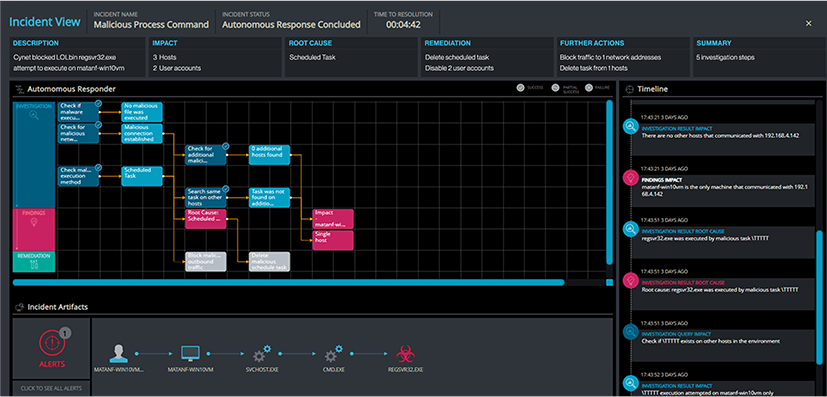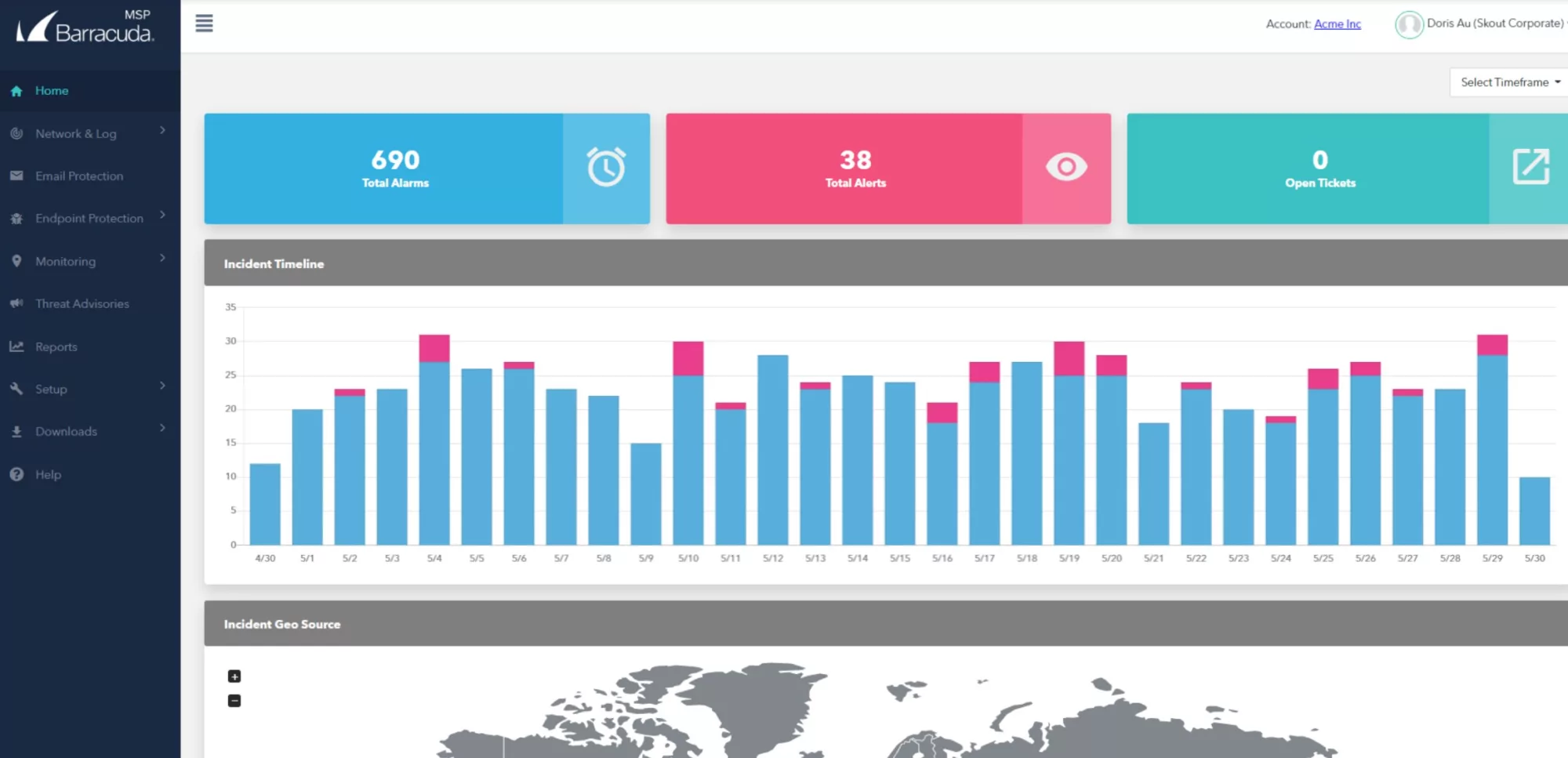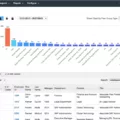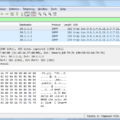XDR (extended detection and response) is a new type of security platform that offers a comprehensive, end-to-end approach to protecting your network. XDR platforms combine threat detection and response capabilities across multiple security layers, including endpoint, cloud, and email security. By combining these layers into one unified platform, XDR provides powerful visibility and control over your entire IT environment.
Unlike traditional endpoint security solutions, which focus primarily on endpoint devices such as laptops and desktops, XDR provides a unified view of threats across all connected devices and systems. This allows organizations to detect threats more quickly and respond with greater agility. Additionally, XDR can provide automated threat detection and response capabilities that enable organizations to quickly identify malicious activity and take action to mitigate the risk.
XDR solutions are offered by several major vendors in the IT security space, including Cynet, Palo Alto Networks, Sophos, McAfee, Microsoft, Symantec, FireEye, and Rapid7. Each of these vendors offers its own unique technology stack that can be used for XDR purposes. For instance, Palo Alto Networks offers an open-overlay architecture that integrates easily with third-party security products while Trend Micro provides full-stack modified solutions that include both native tools as well as ecosystem offerings.
In addition to offering advanced threat protection capabilities across multiple device types and environments, XDR platforms can also provide managed detection and response services (MDR). MDR is a managed service that packages the benefits of EDR (endpoint detection & response) or XDR into an easy-to-use solution. With MDR services in place, organizations can benefit from automated threat identification as well as streamlined incident response processes.
To sum up, XDR platforms offer a powerful set of features for detecting and responding to threats across multiple layers of security in the enterprise environment. By providing centralized access to various security tools along with automated functions for EDR tasks such as threat identification or incident response management; organizations can improve their overall security posture at scale.

Types of XDR
XDR, or Extended Detection and Response, is a type of cybersecurity solution that helps organizations to detect, investigate, and respond to threats across multiple security components in their IT environment. It combines data from multiple sources such as endpoint detection and response (EDR), network traffic analysis (NTA), and security information and event management (SIEM).
There are four distinct types of XDR: overlay, full-stack, full-stack modified, and ecosystem offerings.
Overlay XDR solutions are open-source options that can be implemented in existing IT environments without making major infrastructure changes. They collect data from existing security tools and add a layer of analysis on top of it to provide greater visibility into threats.
Full-stack XDR solutions are natively integrated with an organization’s IT environment so they can function without relying on external sources. This type of solution is typically deployed as a single platform that includes all the necessary components for threat detection and response.
Full-stack modified XDR solutions are offered by full-stack providers who offer customized architectures that integrate better with third-party security products. These solutions are built to fit an organization’s specific needs while still taking advantage of the advanced threat detection capabilities provided by the provider’s platform.
Finally, ecosystem offerings provide users with a range of different pre-integrated products from multiple vendors that work together to form an XDR solution. These offerings enable organizations to benefit from the collective strengths of different products while leveraging existing investments in their existing security systems.
The Difference Between EDR and XDR
The primary difference between EDR (Endpoint Detection and Response) and XDR (Extended Detection and Response) is the scope of protection. EDR is focused on the endpoint, providing in-depth visibility and threat prevention for a particular device. This includes monitoring all activity, detecting malicious behavior, and responding to any potential threats. XDR takes a wider view and integrates security across endpoints, cloud computing, email, and other solutions. This allows for greater visibility of threats across an organization’s entire IT infrastructure. XDR also provides more comprehensive threat intelligence that can be used to detect threats faster and better prioritize resources for further investigation. In short, EDR is focused on protecting one device whereas XDR focuses on protecting multiple devices across an organization’s entire IT infrastructure.
Example of an XDR Solution
XDR (Extended Detection and Response) is an advanced cybersecurity solution that provides automated, real-time detection and response to advanced threats. It combines multiple security technologies such as endpoint protection, network security, user and entity behavior analytics, threat intelligence, and incident response into a single platform.
An example of an XDR solution is Palo Alto Networks’ Cortex XDR product. This product combines endpoint protection with behavioral analytics and cloud-based intelligence to detect malicious activity across the entire attack surface. It also includes automated incident response capabilities to help organizations respond quickly to incidents and mitigate potential damage. Additionally, Cortex XDR integrates with other security products in the Palo Alto Networks portfolio for a complete security stack.
Comparing XDR and MDR
XDR, or Extended Detection and Response, is a security technology that combines data from endpoints, networks, servers, and cloud applications to detect and respond to threats. It provides centralized access to various security tools and automates many of the functions required for EDR (endpoint detection and response).
MDR, or Managed Detection and Response, is a managed service that packages the benefits of XDR into an easily accessible offering. MDR services provide proactive threat detection by leveraging multiple sources of data to identify threats and then respond quickly with automated actions. This gives organizations the ability to detect threats faster than they could on their own. In addition to providing visibility into what’s happening on the network at all times, MDR services also offer 24/7 monitoring of the network for any suspicious activity or changes in behavior.
Understanding XDR Software
XDR (extended detection and response) software is a security analytics platform designed to protect digital assets from advanced threats. It gathers and correlates data from multiple sources, such as email, endpoint, server, cloud workloads, and networks, to detect security threats in real time. XDR provides organizations with an end-to-end view of their security landscape while automating incident investigation and response processes. By automatically collecting and analyzing data from multiple sources, XDR eliminates the need for manual intervention during threat detection and enables faster remediation. Additionally, XDR’s advanced analytics capabilities enable organizations to quickly identify suspicious user activity or malicious code that could lead to a breach.

What Type of Security Solution Does CrowdStrike Offer?
CrowdStrike is both an EDR (Endpoint Detection and Response) solution as well as an XDR (Extended Detection and Response) solution. Falcon Insight XDR builds on the existing endpoint security capabilities of CrowdStrike’s Falcon platform, adding additional layers of protection across the entire attack surface. Its unified detection and response capabilities allow customers to detect threats faster, investigate incidents more effectively, and respond quickly to mitigate any damage.
Is XDR an Alternative to SIEM?
No, XDR is not replacing SIEM. While XDR offers organizations new security capabilities and enhanced protection, it cannot replace SIEM. XDR provides a more comprehensive view of the security environment by combining event data from multiple sources and applying analytics to uncover suspicious activity across the entire enterprise. It can detect events that may have been missed by other security solutions, like SIEM, but it doesn’t replace them.
SIEMs provide a centralized solution for monitoring and analyzing log data from multiple sources in real time. It uses correlation rules to detect malicious behavior and alert administrators of potential threats. SOAR is an automated incident response platform that allows security teams to quickly respond to threats and investigate incidents.
XDR complements SIEMs and SOARs, not replaces them. It provides real-time visibility into threats across the entire organization and enables faster response times for potential incidents. The combination of XDR with SIEM or SOAR provides organizations with a more comprehensive view of their security environment and better protection against malicious attacks.
Is Splunk an Extended Detection and Response (XDR) Solution?
No, Splunk is not an XDR. XDR stands for Extended Detection and Response, which is a type of cybersecurity solution that provides broad coverage across a range of security use cases and data sources. Splunk, on the other hand, provides a comprehensive platform that allows you to search and index all your data. It can be used for threat detection, investigation, and response (TDIR), but it doesn’t provide the same benefits as an XDR solution. Splunk also eliminates the need to deploy additional products, portals, and data models into your crowded technology stack.
Disadvantages of XDR
XDR (Extended Detection and Response) solutions can provide a comprehensive view of an organization’s environment, allowing for faster and more accurate responses to threats. However, there are some potential drawbacks to implementing an XDR solution.
First, the upfront costs associated with purchasing software tools, retraining employees, or hiring expert staff can be significant. Furthermore, planning and implementation can be both time-consuming and expensive if custom integrations are required.
Second, data privacy issues may arise from collecting and analyzing large amounts of data from different sources. Organizations should ensure that any collected data is protected in accordance with GDPR regulations and other applicable laws.
Third, XDR solutions require an abundance of resources to operate efficiently. This includes time spent managing the platform as well as maintaining the infrastructure necessary to support it. Furthermore, troubleshooting any issues related to the XDR platform can be complex and time-consuming.
Finally, organizations should consider their current security posture before implementing an XDR solution as it may not be beneficial due to a lack of resources or lack of maturity in terms of security processes or personnel.
The Benefits of XDR Over EDR
XDR is a more comprehensive approach to security than EDR as it encompasses not only endpoint and network rules but also behavior-based detection engines. XDR offers visibility into events across endpoints, cloud computing, email, and other platforms, making it easier to identify threats that traditional EDR solutions may miss. Additionally, XDR’s behavior analysis engines are designed to detect unknown threats which helps organizations stay ahead of the curve when it comes to cyberattacks. By combining both rules-based and behavior-based detection methods, XDR is able to offer a more robust security solution than traditional EDR solutions.
Understanding XDR in AWS
Amazon Web Services (AWS) XDR is a comprehensive security solution that combines threat detection and response capabilities across AWS cloud environments with extended detection and response (XDR) capabilities for on-premises environments. With AWS XDR, organizations can detect malicious activity, investigate potential threats, and respond quickly to protect their data and systems. The solution supports multiple cloud environments, including Amazon Elastic Compute Cloud (Amazon EC2), Amazon Virtual Private Cloud (Amazon VPC), Amazon Relational Database Service (Amazon RDS), AWS Lambda, and more. AWS XDR provides advanced security analytics capabilities to help you identify suspicious behavior more quickly and accurately while also providing automated responses to reduce the time it takes to remediate threats. Additionally, the solution uses machine learning models to detect anomalous behavior in your environment and provide detailed visibility into your environment so you can prioritize threats based on risk level.
Is SentinelOne an Extended Detection and Response Solution?
Yes, SentinelOne is an XDR (Extended Detection and Response) platform. XDR combines multiple detection and response capabilities into a unified platform that can detect, investigate and respond to threats across the entire attack surface, including endpoints, networks, cloud workloads, and IoT devices. The SentinelOne Singularity Platform is the first solution to incorporate IoT and Cloud Workload Protection Platform (CWPP) into a centralized XDR platform using a single codebase and deployment model. This allows organizations to leverage the power of an extended threat detection and response platform without having to manage multiple solutions.
Conclusion
In conclusion, XDR platforms are designed to provide a comprehensive security solution for organizations of all sizes. They incorporate multiple security tools and technologies, such as EDR and MDR, to provide centralized access and automated threat prevention capabilities. This allows businesses to have a unified view of their security landscape and quickly detect and respond to threats. Popular XDR solutions include those from Palo Alto Networks, Trend Micro, FireEye, Rapid7, McAfee, Microsoft, and Symantec. With the right XDR platform in place, businesses can ensure they have the necessary protection against sophisticated threats.








